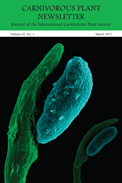International Carnivorous Plant Society
Carnivorous Plant Newsletter Archive
Catapults into a deadly trap: The unique prey capture mechanism of Drosera glanduligera
Hartmeyer, Siegfried R.H. and Irmgard Hartmeyer and Tom Masselter and Robin Seidel and Thomas Speck and Simon Poppinga
Carniv. Pl. Newslett. 42(1):4-14
Published 25 February 2013
https://doi.org/10.55360/cpn421.sh574
Summary
Keywords: catapult-flypaper-trap, cultivation, Drosera glanduligera, functional morphology, plant biomechanics, snap-tentacles
Article Citation
Hartmeyer, Siegfried R.H. and Irmgard Hartmeyer and Tom Masselter and Robin Seidel and Thomas Speck and Simon Poppinga. 2013. Catapults into a deadly trap: The unique prey capture mechanism of Drosera glanduligera. Carniv. Pl. Newslett. 42(1):4-14. https://doi.org/10.55360/cpn421.sh574
Page views: 1036
©2025 International Carnivorous Plant Society
www.carnivorousplants.org
This page is maintained by John Brittnacher.
Please contact us at our membership website, icps.clubexpress.com.
Privacy: The Carnivorous Plant Newsletter Archive website does not track users.

